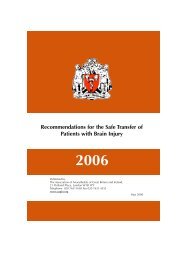TheatrePracticeStandardsGeneric1
Create successful ePaper yourself
Turn your PDF publications into a flip-book with our unique Google optimized e-Paper software.
4. Other equipment<br />
• suction<br />
• battery powered syringe pumps<br />
• battery powered IV volumetric pumps (infusion by gravity is<br />
unreliable during transfer)<br />
• intubation equipment<br />
• self-inflating bag, valve and mask<br />
• venous access equipment<br />
• chest drain equipment<br />
• DC defibrillator<br />
• spare batteries<br />
• warming blanket<br />
5. An adequate supply of essential drugs to go with the patient<br />
• Hypnotics, eg propofol or midazolam<br />
• muscle relaxants, eg atracurium, vecuronium,- suxamethonium<br />
may be required for re-intubation<br />
• analgesics, eg alfentanil, fentanyl,<br />
• anticonvulsants, eg diazepam, thiopentone<br />
• mannitol 20%, furosemide<br />
• vasoactive drugs, eg ephedrine, dopamine, noradrenaline<br />
• resuscitation drugs as in hospital resuscitation boxes<br />
• intravenous fluids<br />
6. Communication equipment<br />
It is essential that the transfer team should be able to communicate<br />
easily with the designated consultant or his deputy in the referring<br />
hospital and the neurosurgical team during the transfer. The benefits of<br />
a mobile telephone which can be pre-programmed with useful<br />
numbers outweigh the minimal risk of it interfering with electronic<br />
equipment.[17]<br />
7. Paediatric equipment<br />
The transfer of paediatric patients will require size specific equipment<br />
and staff experienced in the transfer of critically ill children.[6,7,18]<br />
14





